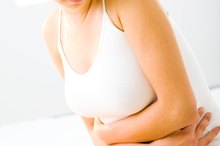Appendicitis Symptoms in Women
Inflammation of the appendix, known as appendicitis, occurs when the appendix -- a long, thin, mobile tubular structure attached to the first part of the large intestine -- becomes blocked by debris. Appendicitis is the most common abdominal condition requiring emergency surgery 6. Classic symptoms occur in only half of people with appendicitis and include nausea, vomiting, fever and pain. While appendicitis occurs slightly more often in men than women, diagnosis can be difficult, especially in women since it may mimic gynecological disorders.
If you are experiencing serious medical symptoms, seek emergency treatment immediately.
Abdominal Pain
When the appendix becomes obstructed with debris, pressure inside the appendix increases, causing a generalized ache around the belly button. As the pressure increases even more and inflammation progresses, the pain typically moves to the right lower abdomen, where the appendix resides. However, the tip of the appendix can sometimes extend down into the pelvis or towards the middle of the lower abdomen, resulting in pain in these less typical areas. With more distension, the appendix can burst. Abdominal pain sometimes lessens for a short time after it ruptures. Without treatment, the pain may eventually become widespread across the abdomen if generalized peritonitis -- inflammation of the lining of the abdominal cavity -- occurs.
- When the appendix becomes obstructed with debris, pressure inside the appendix increases, causing a generalized ache around the belly button.
Fever
Can Spicy Food Cause Your Appendix to Burst?
Learn More
A slight fever is often present in appendicitis, but some people have no fever at all. The presence of a temperature greater than 99 degrees Fahrenheit suggests that a person may have appendicitis, but it is only a weak predictor, according to a study reported in the October 2004 issue of the journal “Academic Emergency Medicine.” This means that you can still have appendicitis even if your temperature is less than this 3. On the other hand, some people with appendicitis have a high fever, especially if their appendix has ruptured.
- A slight fever is often present in appendicitis, but some people have no fever at all.
- The presence of a temperature greater than 99 degrees Fahrenheit suggests that a person may have appendicitis, but it is only a weak predictor, according to a study reported in the October 2004 issue of the journal “Academic Emergency Medicine.”
Gastrointestinal Symptoms
Loss of appetite is a very common symptom of appendicitis. As the process of obstruction and inflammation of the appendix worsens, you will likely develop progressive loss of appetite and nausea. Vomiting may be present, but it is not usually a major symptom. Constipation and diarrhea may also occur with appendicitis.
- Loss of appetite is a very common symptom of appendicitis.
Appendicitis in Pregnancy
Causes of Lower Left-Side Abdominal Pain
Learn More
Acute appendicitis can occur during pregnancy 3. The diagnosis may be challenging because the appendix is displaced by the enlarged uterus, and the pain may not localize to the right lower abdomen. Instead, it may be felt anywhere on the right side of the abdomen. Appendicitis pain may also be misinterpreted as representing early labor. The other symptoms of nausea, vomiting and lack of appetite associated with appendicitis are not specific for appendicitis and may be related to the pregnancy itself. Appendicitis alone poses little risk, but a ruptured appendix can be very serious for the mother or baby, according to a review in the September 2006 issue of the “British Medical Journal. 35”
Warnings
Because the appendix may be located in the pelvis, appendicitis in women can be confused with abnormalities of the pelvic organs, including ruptured ovarian cysts, twisting of the right ovary or bowel conditions such as colitis. Laboratory tests and imaging studies such as ultrasound or computed tomography scanning can help make the correct diagnosis. Contact your doctor if you have a fever or persistent abdominal pain, loss of appetite, nausea or vomiting. Seek medical attention for any abdominal pain if you are pregnant.
- Because the appendix may be located in the pelvis, appendicitis in women can be confused with abnormalities of the pelvic organs, including ruptured ovarian cysts, twisting of the right ovary or bowel conditions such as colitis.
Related Articles
References
- Radiology: Appendicitis at the Millennium
- Radiology: Right Lower Quadrant Pain and Suspected Appendicitis in Pregnant Women: Evaluation With MR Imaging-Initial Experience
- British Medical Journal: Acute Appendicitis
- British Medical Journal: A Notable Source of Error in the Diagnosis of Appendicitis
- Annals of Surgery: Appendicitis Near Its Centenary
- Jones MW. Appendicitis. StatPearls [Internet]. December 2018.
- Johns Hopkins Medicine. Appendicitis.
- Shogilev DJ, Duus N, Odom SR, Shapiro NI. Diagnosing appendicitis: evidence-based review of the diagnostic approach in 2014. West J Emerg Med. 2014;15(7):859-71. doi:10.5811/westjem.2014.9.21568
- National Institute of Diabetes and Digestive and Kidney Diseases. Symptoms and Causes of Appendicitis.
- Choi JY, Ryoo E, Jo JH, Hann T, Kim SM. Risk factors of delayed diagnosis of acute appendicitis in children: for early detection of acute appendicitis. Korean J Pediatr. 2016;59(9):368-373. doi:10.3345/kjp.2016.59.9.368
- National Institute of Diabetes and Digestive and Kidney Diseases. Treatment for Appendicitis.
Writer Bio
Dr. Terry L. Levin is professor of clinical radiology at a New York childrens hospital where she has been for 15 years. She received her MD from Cornell University Medical Center,completed her radiology residency at New York Hospital-Cornell Medical Center and her fellowship in pediatric radiology at Columbia Presbyterian Medical Center.






